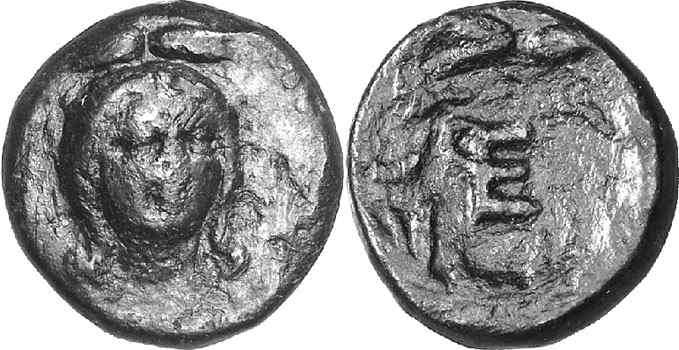H 170 - Hermione, bronze, trichalkoi (360-325 BCE)
From SILVER
360 BCE - 325 BCE Bronze
Description
| ObverseInscription or printing placed on the obverse.: | Facing head of Demeter |
| ReverseInscription or printing placed on the reverse.: | (Greek).Monogram of within wreath |
Mint and issuing power
| MintIdentifies the place of manufacture or issue of a numismatic object.: | Hermione | Ancient regionAncient region.: | Peloponnesus | Modern countryModern country: Greece | AuthorityIdentifies the issuing power. The authority can be "pretended" when the name or the portrait of X is on the coin but he/she was not the issuing power. It can also be "uncertain" when there is no mention of X on the coin but he/she was the issuing power according to the historical sources: |
Chronology
| FromIdentifies the initial date in a range assigned in a numismatic context. | 360 BCE | toIdentifies the final date in a range assigned in a numismatic context.. | 325 BCE | PeriodTime period of the numismatic object.: Classical 480-323 BC |
Physical description
| MetalThe physical material (usually metal) from which an object is made.: | Bronze |
Median weightMedian of the weights of numismatic objects (in grams). in grams | 3.10 | DenominationTerm indicating the value of a numismatic object. Examples: tetradrachm, chalkous, denarius.: | trichalkon |
StandardStandard.: |
Image

H170 Hermione trichaloi.jpg [1]
References
| Die study referencePublication of the study: | Grandjean 19901Grandjean 1990, p. 39-41 | ||
| Coin series referenceReference to coin series study: | Sear I2Sear I, n° 2818, RQEMH3RQEMH, n° 170 | ||
Obverse dies distribution
| FrequencyFrequency of specimen in distribution. ᵖ | Number of obversesNumber of obverse dies. ᵖ (o) | % (o) | Number of coinsNumber of coins. (n) | % (n) | Die nameName(s) of the die(s). |
| 1 | 10 | 62.5 | 10 | 41.67 | 65, 68, 70, 71, 72, 73, 74, 75, 76, 80 |
| 2 | 4 | 25 | 8 | 33.33 | 67, 69, 77, 79 |
| 3 | 2 | 12.5 | 6 | 25 | 66, 78 |
| Total | 16 of 16 | 100 | 24 of 24 | 100 |
Reverse dies distribution
no distribution is available
Quantification
| Number of obversesNumber of obverse dies. ᵖ (o) | 16 | Number of singletons (o1)The number of singleton coins. ᵖ | 10 |
| Number of reverse diesNumber of reverse dies. (r) | 18 | Number of coinsNumber of coins. (n) | 24 |
| Coins per obverse dieNumber of coins per obverse die. (n/o) | 1.5 | Coins per reverse dieNumber of coins per reverse die. (n/r) | 1.33 |
| Reverse per obverse ratioRatio of obverse dies divided by reverse dies. (r/o) | 1.13 | Percentage of singletons (o1)number of coins (n) divided by the number of singletons (o1) ᵖ | 62.5 % |
| Original number of dies (O) (Carter 1983 formula)The estimation of the number of coins according to Carter 1983 ᵖ | 38.46 | Coins struck if 20,000 as average productivity per dieCoins made if the average productivity for obverses (according to Carter) is 20,000. ᵖ | 769,200 |
| Original number of dies (O) (Esty 2011 formula)The estimation of the number of coins according to the singleton formula in Esty 2011 ᵖ (O) | 48 | Survival rate if 20,000 as average productivity per dieSurvival rate if average productivity is 20,000. ᵖ | 0.00003 |
| Coverage (o = % of O) (Esty 1984 formula)Esty 1984 - coverage (% of O) ᵖ (o = % of O) | 58.33% | Die productivity if survival rate 1/2,000Average productivity if survival rate is 1/2,000. ᵖ | 1,248.05 |
| Weight of silver (in kg) if 20,000 coins per die (O = Carter formula)Carter 1983 * Median weight * 20000 (*10 if gold or electrum) ᵖ | n.a. | Die productivity if survival rate 1/5,000Average productivity if survival rate is 1/5,000. ᵖ | 3,120.12 |
Remarks
References
- ^ Grandjean, Catherine (1990), "Le monnayage d'argent et de bronze d'Hermioné, Argolide", Revue Numismatique, 32, p. 28-55, pl. 8-11.
- ^ Sear, David R. (1978), Greek coins and their values. Vol. I, Europe, London, xl, 316 p.
- ^ Callataÿ, François de (1997), Recueil quantitatif des émissions monétaires hellénistiques, Numismatique Romaine, Wetteren, X + 341 p.